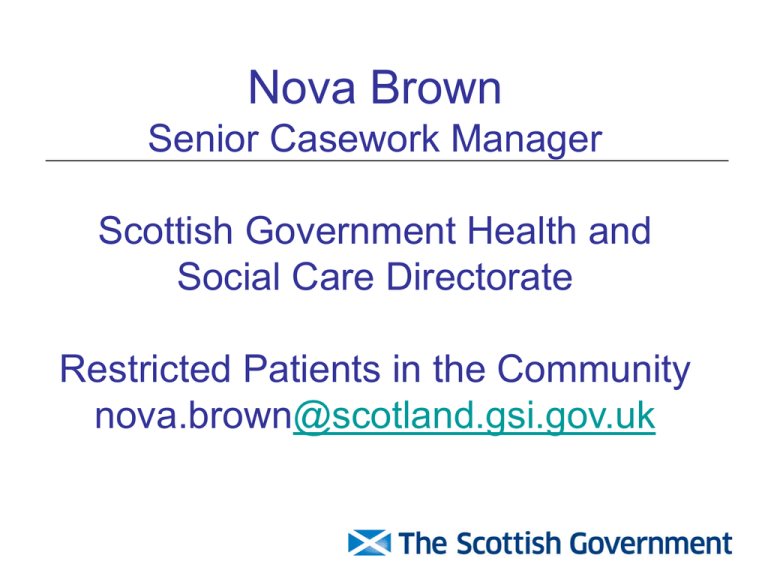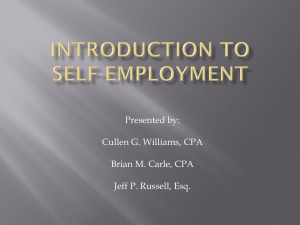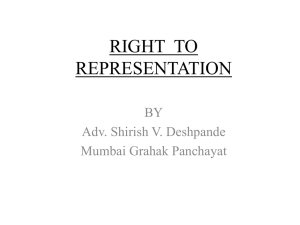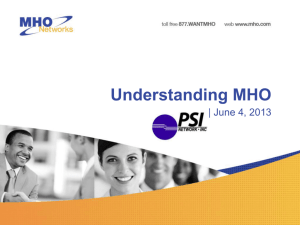
Nova Brown
Senior Casework Manager
Scottish Government Health and
Social Care Directorate
Restricted Patients in the Community
nova.brown@scotland.gsi.gov.uk
Introduction
Restricted Patients
- legislative background
Policy
Role of Scottish Ministers, PMO and officials
Management of Offenders Legislation/CPA
Anonymised case for discussion
Memorandum of Procedure
Role of MHO
Training – why so important
Bryan Homicide Inquiry
Test for Restriction Order
• Section 59A
(a) having regard to the nature of the offence with which
he is charged
(b) the antecedents of the person and
(c) the risk that as a result of his mental disorder he
would commit offences if set at large
that it is necessary for the protection of the public from
serious harm so to do, the court may, subject to the
provisions of this section, further order that the person
shall be subject to the special restrictions set out in Part
10 of the Mental Health (Care and Treatment) (Scotland)
Act 2003 without limit of time.
Recent Policy
• The policy in relation to restricted patients has developed
further over recent years and been informed by:
– The MWC Report on the inquiry into the care and
treatment of Mr L and Mr M
– The Risk Management Authority’s recommendations
on working with restricted patients
– The Forensic Mental Health managed Care Network
(Forensic Network) – see NHS HDL(2006)48 and
NHS CEL 13 (2007)
– The Management of Offenders etc (Scotland) Act and
revised CPA
The MWC Inquiry Report into Mr L
and Mr M
– No systematic approach to risk assessment
– No risk management plan or strategy to deal with
relapse
– No crisis plan
– a need for care governance around training, skills and
knowledge of those providing social work support for
restricted patients
– In the Inquiry’s view, this includes mental state and
risk assessment skills, as well as generic social work
skills.
Mr L and Mr M: important
conclusion...
Medical treatment and risk management are
not the same. Irrespective of improvement
and recovery in response to treatment, the
risk posed by an individual patient must
always be considered separately and
determine the degree of liberty enjoyed by
a patient.
Mental Welfare Commission (Report into the inquiry of Mr L and Mr M,
March 2006)
RMA Recommendations
• Standardised CPA
• Formal risk assessment reviews at predefined
key stages in the patient journey
• Training should be developed and provided to
multidisciplinary teams including
– Management of MDOs; risk assessment and
management; managing restricted patients (use of
the MOP); and multidisciplinary working
Key is balanced judgement
“it is understood that there is inherent
uncertainty in the processes of risk
assessment and risk management. The goal
is not to predict adverse events nor to have
overly risk-aversive practice..... risk can be
reduced and managed but never eliminated...
“SG must be satisfied that the MDT have
properly identified and evaluated any risk to
the public and that sound measures have
been taken to manage it
RESTRICTED PATIENT CASELOAD
Number of restricted patients (as at 28.09.12)
Number of remand patients (restricted status)
324
30
Number of restricted patients (excl remand) in:
State Hospital
Orchard Clinic
Rowanbank Clinic
Local Hospitals
Conditional Discharge
Total
98
20
39
86
51
294
Role of Scottish Ministers
• The 2003 Act gives Scottish Ministers a specific
statutory role in respect of restricted patients
• The oversight of Scottish Ministers provides
safeguards as follows:
– A compulsion order lasts only 6 months unless
renewed by the RMO. A RO is without limit of time
– A RO prevents a patient being released from
compulsion (either in hospital or in the community)
without a decision of the Tribunal at which SMs can
make representations
Scottish Ministers (Cntd)
• Decisions about transfer of the patient – ie to lower security
hospitals are subject to scrutiny and approval of SMs (S218)
• Decisions about SUS require SMs consent and SUS can be revoked
at any time (S224)
• A RO involves SMs monitoring the patient on a continuing basis
• Conditional Discharge allows supervision, assessment and
monitoring in the public interest and patient can be recalled from
CD at any point
• Scottish Ministers can vary conditions of discharge (done in
discussion with the multi-disciplinary team)
• To reflect risk considerations for Mental Health Tribunal hearings
Role of the Principal Medical Officer and
officials in the SG Health Directorate
• The Principal Medical Officer (Forensic Psychiatry) is a
psychiatrist who is responsible for liaison with the RMO
and for advising Scottish Ministers and their
administrative officials on clinical aspects
• Officials in MHD are responsible for administrative
matters generally in relation to casework on restricted
patients. Decisions which are not taken personally by
SMs are taken on their behalf by officials on the advice
of the PMO
Role of Officials/PMO (FP)
Casework
• Review all annual reports/MHO reports/care plans/risk
assessment/CPA minutes etc
• Review all reports of adverse incidents
• Patient reviews – every 6 months-2 years
–
–
–
–
–
Review file and recent reports
Discuss case with RMO/MHO and other team members
Interview patient with RMO/team members/advocacy
Discuss issues with case workers
Produce written report for file, RMO/MHO and MWC
Role of PMO (FP)/Officials (cont)
• Available to discuss issues/advise clinical team
members by telephone
• Attend CPA meetings as required
• Attend branch meetings/CORO meetings/meetings with
SGLD and Counsel
• Out-of-hours on call for reporting of adverse
incidents/permission for emergency suspension of
detention
Role of PMO (FP)/Officials (cont)
Advice to SMs/Decisions taken on behalf of SMs
• State Hospital outings
• Suspension of Detention outwith hospital grounds
(decisions on life sentence prisoners always taken
personally by SMs)
• Transfers between hospitals and units (decisions on
transfers to lower level of security always taken by SMs
• Transfers from hospital to prison
Role of PMO (FP)/Officials (cont)
• Cross border transfers (decisions always taken by SMs
when drop in level of security)
• Variation of conditions of discharge
• Recall from conditional discharge
• Advise re Position Statements in cases referred
to/applications/appeals to MHT to reflect risk
• Advise re media enquiries/press
statements/Parliamentary Questions etc
• Advise re Parole Board reviews
• Provide training events at SAH and available to assist
teams in provision of training locally
CPA in practice
• Multi-agency working vital via CPA
• Risk Assessment Documentation should be prepared prior to
CPA with contribution from all relevant agencies
• Risk Management/ Contingency Plan traffic light Flowchart for
information sharing
• Patient engagement
• Risk Assessment Tools and understanding between agencies of
the tools each use
• More than just High, Medium or Low risk
• Risk Assessments should be ongoing
• Planning and Contingency Planning vital
Scottish Ministers’ expectations of
CPA
• Contact details of multi-agency representatives incl
police and CPNs (as they are part of reporting process
now);
• MHO attendance
• note of meeting (currently not included in all CPA
paperwork);
• pre-CPA where appropriate with 3rd party notes/victim
info;
• details of offence;
• schedule 1 notification;
• sex offender;
Scottish Ministers’ expectations of
CPA
•
•
•
•
•
•
date of first statutory review;
date of next CPA review date;
MAPPA notification/referral made.
MHO representation as integral part of team
police rep involved where appropriate.
traffic
light
risk
assessment/management
and
contingency plan including risk of abscond
• Informing restricted patient team when “red” or “amber”
incidents occur
• Dedicated CPA co-ordinator
Police role
Police have two key roles in relation to
management of restricted patients:
• Sharing information to help the responsible
authority (Health) assess and manage risk
appropriately
• To help address community safety issues when
patients are moving towards spending time in
the community or discharge to the community
Police engagement with CPA
Police engagement
• Admission – allows suitable police liaison officer to be
identified and will assist with gathering of intelligence of the
risk assessment process
• When consideration of escorted/unescorted or in certain
circumstances escorted leave within hospital grounds
• Prior to accommodation being identified for patient
progressing towards conditional discharge
• When a breach of condition occurs or if a patient is
recalled
• Any other occasion when it can be demonstrated that a
police officer’s presence is essential
MAPPA referrals
• Consideration of unescorted SUS incl
within hospital grounds
• At point when accommodation
identified and progressing towards CD
• Recommendation for revocation of
CO or RO or CD
Conditional Discharge
• Subject to conditions ie residence, supervision,
structure, drug/alcohol testing,
• Can have condition must not enter specific area
(ie if victim concerns)
• Ministers may recommend conditions to MHT
but ultimately decision for MHT
• Ministers may vary conditions of discharge whilst
patient is on CD ie either relax or strengthen
Anonymised case
• For the index offence Mr X was found with a replica gun and 24
wraps of heroin. He had a previous conviction for assault to severe
injury – charge reduced from attempted murder - by stabbing.
• Diagnosis of paranoid schizophrenia and personality disorder
• He was admitted to State Hospital before being transferred to local
facility and conditionally discharged.
• He was recalled from CD after misusing drugs and becoming
psychotic (18 months) – subsequently admitted to using flushing kits
• He was re-CD’d and has been in community for nearly 2 years
Anonymised case (cntd)
• He continually pushes at boundaries.
• In 2010 he tested positive for illicit substances
• His attendance at structured activities declined – partly
because of unwillingness to attend and also because of
the closure of one of the projects
• Jan 2011 his OT reported he continued to deflect/avoid
her – contact stopped but restarted again
• April 2011 tested positive for illicit substances and
admitted to accruing a gambling debt
Anonymised case (contd)
•
•
•
•
•
June 2011 PMO noted marked persecutory tone
June 2011 RMO stopped medication
Refused to give urine sample in August
Refused to give urine sample in September
October – RMO described patient suffering headaches,
palpitations, rashes, allergies, chest pain, jaw clenching
and a number of stressors including owing money,
difficulties in relationships and illnesses in family
• Urgent CPA meeting held – what would you
recommend?
Memorandum of Procedure
• An essential reference document for those
involved with the management and care of
restricted patients
• The MOP also sets out information in
relation to certain patients subject to other
types of mental health orders
• It is not intended as an authoritative
interpretation of the law
Updated MOP
• Executive Summary focusing on clinical governance,
events influencing policy etc
• New guidance on risk assessment and management
produced in conjunction with the Risk Management
Authority
• Incorporation of MAPPA guidance
• Updated legal guidance following JK, MM, Gatt and Fallon
• Updated CPA guidance incorporating suspension of
detention and dispensing with the old Annex B2 and B3
forms
• New reporting forms for the RMO and MHO including new
reporting role for CPNs
• Mock RMO annual reports and MHO reports
Role of MHO
• A MHO is a qualified and experienced social worker
• MHOs are also expected to have undertaken some level
of forensic MHO training
• A restricted patient must have a designated MHO at all
stages of their care
• The MHO provides reports annually – see P163-177 for
example of Mock MHO report in MOP
• Attendance at clinical team meetings
• Attendance at Care Programme Approach meetings
Role of MHO (cntd)
In hospital –
• Explain to the patient their rights in relation to advocacy
• Explain to the patient their rights in relation to legal
representation
• Explain the Tribunal process to the patient
• Explain the role of the named person and their right to
receive full Tribunal papers
• Liaise with community services
• Contribute to risk assessment and risk management
planning and consideration of SUS
Role of MHOs (cntd)
CORO patients on conditional discharge
• Any breach of CD should trigger
consideration of recall or other appropriate
action
• Monthly/3 monthly reports (MHO
supervisor form)
• Annual report
Role of MHO (cntd)
It would also be good practice for MHOs to:
• Ensure the named persons have an understanding of the
reasons for the patient’s detention
• Ensure named person understands that they will receive
background details of index offence which may be
distressing
• Support named person to sensitive nature of papers and
how they may store and dispose of them
• Advise others of any changes relating to the named
person
Reporting by MHOs
• Includes CD details
– Date of CD
– Reporting interval
– Any changes to patient’s social circumstances
• Meetings since last report
– Dates of CPA meetings
• Contact with patient
– Dates
– Compliance
Training
Restricted Patient team run training events which cover:
• The role of Scottish Ministers, Officials, Principal Medical Officer
(Forensic) and the multi-disciplinary team
• a presentation on the legal tests set out in S193 of the Mental Health
(Care and Treatment) (Scotland) Act 2003
• Memorandum of Procedure/MAPPA/Role of police – see
http://www.scotland.gov.uk/Publications/2010/06/04095331/0 • an opportunity to meet the restricted patient team – events on 4
October and 27 February 2013
Training cntd
SG RC&MHD web page provides a package of
training materials which include –
•
•
•
•
•
•
Overview of MDO policy and care pathway
Brief Outline of Criminal Justice system
MHO reports for court
Case studies
Risk Management Training Material
S193 legal tests
Some reasons why training for MHOs is
important
Recommendation from the RMA
• Training should be developed and provided to
multidisciplinary teams including:
– Management of MDOs; risk assessment and
management; managing restricted patients (use of
the MOP); and multidisciplinary working
• Mr L & Mr M Inquiry concluded that there were clear
deficiencies within the training and supervision of the
FCPNs and Social Workers working with restricted
patients.
Mr L & Mr M (cntd)
• The Social Work Department must ensure
that these social workers have the
necessary competencies and training to
carry out their supervisory function.
• In the Inquiry’s view, this includes mental
state and risk assessment skills, as well as
generic social work skills.
MWC inquiry into the care and
treatment of Mr F
• Report found that patient had received
good care and treatment for alcohol but
illness undertreated
• The team’s closeness to his case did not
allow them to recognise the true extent of
his psychosis or the level of risk
• Complexity of patient’s care needs and
risks indicated a clear role for use of CPA
Care and Treatment of Peter Bryan
“If any single lesson can be learned from the
analysis of the care of Peter Bryan, it
should be that responsibility for managing
and treating Section 37/41 Mental health
Act 1983 (MHA) patients should only be
given to professionals who have sufficient
experience and training to look after such
individuals”
Peter Bryan Homicide
• Peter Bryan was a restricted patient on conditional discharge at the
time of the killing of Brian Cherry
• In March 1993 he had killed NS, the 21-year-old daughter of his
employer by hitting her over the head with a hammer and received a
Hospital Order and Restriction Order
• Other than a couple of minor incidents during his 7 years at
Rampton Hospital, Peter Bryan had not displayed any signs of
aggressive or violent behaviour
• On 28 March 2001 a Tribunal concluded that he could be CD’d and
deferred discharge to allow package to be put in place
• In July 2001 he was transferred to medium security
• In February 2002 he was conditionally discharged
Homicide (cntd)
• On 17 February 2004 Peter Bryan killed Brian Cherry.
• In April 2004, just ten days after being transferred to Broadmoor
Hospital following the homicide, Peter Bryan killed a fellow patient,
• This Inquiry investigated only the homicide of Brian Cherry. A
separate Inquiry Panel investigated the homicide of Richard
Loudwell
“When he is relapsing he can appear relatively free of
symptoms much of the time…In my view, this is a
measure of how, when psychotic, he can appear
relatively normal while remaining capable of extreme and
unpredictable violence.”
General
• PB did not display the usual signs of schizophrenia,
signs were subtle and he appeared to behave normally
even when seriously unwell
• RMO had caseload of about 70 patients on enhanced
CPA and responsibility for 14/15 inpatients
• Social worker had only 5 months experience as a
general social worker and no training in mental health
• His role was described as “more like a mentor”
• The CPN was isolated from the rest of the team and not
part of the general CMHT
General (Cntd)
• Panel found there was a lack of effective management of PB in
community
• Had PB been under care of CMHT overall focus of assessment and
intervention would have been on controlling his behaviour rather
than attempting to normalise it and the threshold was likely to have
been much lower for signs of risk or relapse
• Despite being compliant he constantly complained about conditions
of CD
• Mixing with people marginalised by society and not warned of
dangers
• RMO, despite telling patient it would not be appropriate to reduce
medication, allowed himself to be persuaded and did so despite
going on holiday for 5 weeks
• The hostel described PB’s bedroom “as a schizophrenic bedroom”
General (Cntd)
• Continued to manipulate events, behaviour more erratic, sleep
pattern disturbed
• Tested positive for amphetamines
• CPN concerns about relapse; hostel raised more concern about
state of bedroom, he was challenging everything
• Admitted to smoking cannabis
• Serious allegation of sexual assault by a 17 year old female
• All concerns appear to have been considered individually and none
of professionals took overview of the cumulative effective
• Despite serious allegation of indecent assault no attempt was made
by CPN or SW to see PB immediately
• Home Office not told about the allegations
Recommendations
• A number of the recommendations would be met
in Scotland by the use of CPA and MAPPA
• On every handover the diagnosis of a restricted
patient should be reviewed specifically to include
co-morbidity (in particular PD and substance
misuse)
• Training should include specific training on the
effective management of restricted patients
Useful web links
• MOP: Working version is available on
http://www.scotland.gov.uk/Publications/2010/06/0
4095331/0
• Forensic Managed Care Network
www.forensicnetwork.scot.nhs.uk
• Risk Management Authority Report on Risk
Assessment and Management of RPs at
www.RMAscotland.gov.uk
• Version 5 of MAPPA guidance
http://www.scotland.gov.uk/Publications/2008/0
4/18144823/0
Angiolina Foster
Directorate for Health & Social Care Integration
0131 244 3210
Geoff Huggins
Head of Division
0131 244 3749
Dr Tom White
PMO – Forensic Psychiatry
0131 244 2809
Rosie Toal
Team Leader
0131 244 2510
Ian Taylor
A-G
Senior Casework
Manager
0131 244 2459
Jenny McNeill
Me-Z
Senior Casework
Manager
0131 244 1818
Nova Brown
H-Ma (incl Mc)
Senior Casework
Manager
0131 244 2546
Martin McPheeley
Casework Manager
0131 244 2512
Lorraine Whigham
Casework Manager
0131 244 2171
Jenny Craigie
Casework Manager
0131 244 2457
Eleanor Smith
Casework Officer
0131 244 2170
Noelle Perrett
Casework Officer
0131 244 2545
Adrian Sutherland
Casework Officer
0131 244 6929
Audrey Montgomery
Secretary
01383 825762










